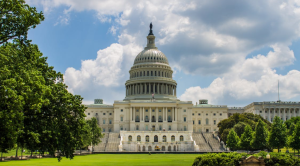
The United States is at a pivotal moment in the deployment of carbon management technologies. The nationwide adoption of carbon management technologies is crucial for balancing the increasing need for affordable, reliable energy that drives the American economy with the global imperative to reduce carbon emissions. Together, they are an enabling technology platform to produce cleaner energy and materials, and they are important in the effort to continue growing our economy and providing Americans with family-sustaining jobs.
In the recently released 2025 Federal Policy Blueprint, the Carbon Capture Coalition outlines for Congress and the current administration a portfolio of necessary legislative, regulatory, and implementation actions to support responsible, nationwide scale up of the carbon management industry to achieve these goals.
Convened by the Great Plains Institute (GPI), the Carbon Capture Coalition is a nonpartisan collaboration of more than 100 companies, unions, and conservation and environmental policy organizations building federal policy support to enable economywide, commercial-scale deployment of carbon management technologies. Developed through a consensus-based process, the blueprint aims to drive the commercial deployment of these essential technologies over the next decade.
Progress and gaps in carbon management deployment
Globally, the United States leads in carbon management deployment. According to the latest annual status report from the Global CCS Institute, the US has 19 commercial-scale facilities operating with a capacity to capture over 22 million metric tons of carbon dioxide (CO2). More than half of the announced projects in the US plan to store CO2 in secure geologic formations, highlighting the effectiveness of the federal incentive structure.
With federal policies driving record domestic investment in carbon management projects over the past few years, the Global CCS Institute report also shows that the number of announced projects in the US—which includes the capture, removal, reuse, storage, and transport of CO2 and carbon monoxide from industrial sites, power generation, and directly from the atmosphere—has risen from 154 in 2023 to 276 in 2024. These projects represent a planned capture capacity of nearly 200 million metric tons annually, demonstrating growing momentum.
Despite this impressive progress and federal incentives that have helped many projects move forward, challenges remain in financing, permitting, and infrastructure development.
In its Credible Pathways to 1.5°C report, the International Energy Agency estimates the global carbon management industry will need to capture or remove 1.2 gigatons of CO2 per year between now and 2030 to reach net-zero emissions by midcentury. To reach this goal, we need to add carbon capture to at least 10 new industrial or power facilities per month by 2030.
Federal policies must help projects advance in construction and operation to contribute to economic growth and long-term jobs while reducing emissions.
Legislative priorities for carbon management
Policy makers must take targeted action to ensure these projects reach construction and operation. The following recommendations outline key steps to secure investment, accelerate deployment, and maximize economic and environmental benefits.
Ensuring investment certainty
The 45Q tax credit and other policies have provided historic federal investment, but refinements are needed. The 2025 policy blueprint recommends the following:
- Enhance 45Q incentives: Adjust for inflation, extend the payment window, and ensure parity between utilization and storage to maintain project viability.
- Reduce regulatory barriers: Streamline 45Q approval processes and clarify IRS guidance on implementation details.
- Strengthen financing mechanisms: Extend direct pay for 45Q’s full duration to support long-term investment.
Expanding carbon transport & storage infrastructure
A reliable CO2 transport and storage network is essential for scaling carbon management. Recommended actions from the blueprint:
- Improve permitting efficiency: Provide resources for timely approvals and establish clear environmental standards.
- Expand and regulate pipeline infrastructure: Support new CO2 pipelines, create an optional pathway for federal siting authority for CO2 pipelines, and maintain high safety standards.
- Streamline CO2 storage regulations: Improve Class VI permitting timelines, clarify storage rules for federal lands and the Outer Continental Shelf, and reform the Underground Injection Control Class VI permitting program.
Driving demand for carbon management technologies
Increasing demand signals to the market for carbon management technologies ensures continued American leadership in the sector. Recommended actions from the blueprint:
- Measure emissions intensity of US goods: Collect data to inform trade and procurement policies.
- Leverage trade mechanisms to strengthen US leadership in carbon management: Explore policies that position American industry competitively.
- Expand CO2 offtake through reforms: Update the financing program to improve infrastructure development.
- Develop carbon marketplace standards: Establish clear guidelines to expand participation and impact.
- Increase federal procurement of carbon management technologies: Ensure long-term demand through government purchasing programs.
Advancing next-generation technologies
Continued innovation is critical for long-term deployment. Recommended actions from the blueprint:
- Advance carbon storage projects: Implement provisions from the Bipartisan Infrastructure Law.
- Support commercialization of key technologies: Provide targeted investments to help projects reach scale.
- Facilitate community engagement in carbon reuse projects: Offer technical assistance for project developers.
- Ensure robust funding for next-generation solutions: Secure adequate appropriations for research and development.
Establishing a supportive energy package
The blueprint also recommends that any future energy package should also accomplish the following:
- Fund research on CO2 pipeline technology: Support materials innovation and advanced leak detection methods.
- Scale large-scale demonstration projects: Provide funding across multiple emitting sectors.
- Expand federal support for emerging carbon management solutions: Strengthen initiatives for nascent technologies.
- Improve monitoring, reporting, and verification (MRV) protocols: Standardize MRV across all carbon management pathways.
- Create a Department of Energy pilot program for industrial 45Q projects: Close cost gaps for first-of-a-kind deployments in heavy industry.
Next steps for federal action
While progress in carbon management is well underway, targeted federal action is needed to ensure announced and future projects reach full-scale operation. Congress and the administration must refine policies to secure investment, expand infrastructure, adjust the 45Q tax credit for inflation, and streamline permitting and regulations. Doing so will enable carbon management technologies to cut emissions, strengthen US industry, protect the nation’s competitive status internationally, and create and retain high-wage jobs nationwide.
Read the Carbon Capture Coalition’s 2025 Federal Policy Blueprint.


